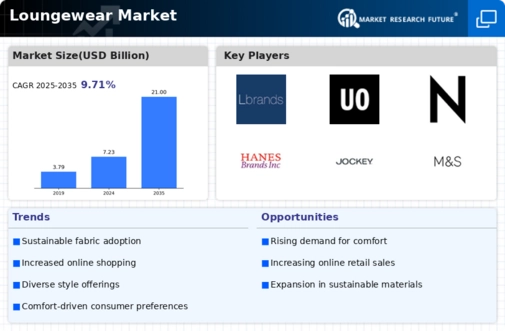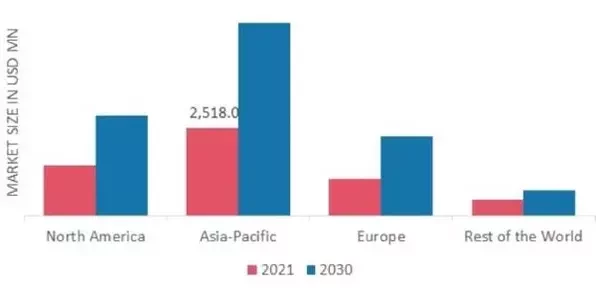-
EXECUTIVE SUMMARY
-
MARKET INTRODUCTION
-
Market Definition
-
Scope of the Study
- Research Objectives
- Assumptions & Limitations
-
Market Structure
-
MARKET RESEARCH METHODOLOGY
-
Research Process
-
Secondary Research
-
Primary Research
-
Forecast Model
-
MARKET LANDSCAPE
-
Supply Chain Analysis
- Raw Material Suppliers
- Manufacturers/Producers
- Distributors/Retailers/Wholesalers/E-Commerce
- End Users
-
Porter’s Five Forces Analysis
- Threat of New Entrants
- Bargaining Power of Buyers
- Bargaining Power of Suppliers
- Threat of Substitutes
- Internal Rivalry
-
Impact of COVID-19 outbreak on Global Loungewear Market
- Impact on Production
- Impact on Consumer Buying Behavior
- Impact on Pricing
- Impact on Store-Based VS Non-Store-Based Sales
- Others
-
MARKET DYNAMICS OF THE GLOBAL LOUNGEWEAR MARKET
-
Introduction
-
Drivers
-
Restraints
-
Opportunities
-
Challenges
-
GLOBAL LOUNGEWEAR MARKET, BY MATERIAL
-
Introduction
-
Cotton
- Market Estimates & Forecast, 2024-2032
- Market Estimates & Forecast, by Region, 2024-2032
-
Wool
- Market Estimates & Forecast, 2024-2032
- Market Estimates & Forecast, by Region, 2024-2032
-
Silk
- Market Estimates & Forecast, 2024-2032
- Market Estimates & Forecast, by Region, 2024-2032
-
Others
- Market Estimates & Forecast, 2024-2032
- Market Estimates & Forecast, by Region, 2024-2032
-
GLOBAL LOUNGEWEAR MARKET, BY END USER
-
Introduction
-
Female
- Market Estimates & Forecast, 2024-2032
- Market Estimates & Forecast, by Region, 2024-2032
-
Male
- Market Estimates & Forecast, 2024-2032
- Market Estimates & Forecast, by Region, 2024-2032
-
Kids
- Market Estimates & Forecast, 2024-2032
- Market Estimates & Forecast, by Region, 2024-2032
-
GLOBAL LOUNGEWEAR MARKET, BY DISTRIBUTION CHANNEL
-
Introduction
-
Store-Based
- Market Estimates & Forecast, 2024-2032
- Market Estimates & Forecast, by Region, 2024-2032
- Supermarkets & Hypermarkets
- Specialty Stores
- Others
-
Non-Store-Based
- Market Estimates & Forecast, 2024-2032
- Market Estimates & Forecast, by Region, 2024-2032
-
GLOBAL LOUNGEWEAR MARKET, BY REGION
-
Introduction
-
North America
- Market Estimates & Forecast, 2024-2032
- Market Estimates & Forecast, by Material, 2024-2032
- Market Estimates & Forecast, by End User, 2024-2032
- Market Estimates & Forecast, by Distribution Channel, 2024-2032
- Market Estimates & Forecast, by Country, 2024-2032
- US
- Canada
- Mexico
-
Europe
- Market Estimates & Forecast, 2024-2032
- Market Estimates & Forecast, by Material, 2024-2032
- Market Estimates & Forecast, by End User, 2024-2032
- Market Estimates & Forecast, by Distribution Channel, 2024-2032
- Market Estimates & Forecast, by Country, 2024-2032
- Germany
- UK
- France
- Spain
- Italy
- Rest of Europe
-
Asia-Pacific
- Market Estimates & Forecast, 2024-2032
- Market Estimates & Forecast, by Material, 2024-2032
- Market Estimates & Forecast, by End User, 2024-2032
- Market Estimates & Forecast, by Distribution Channel, 2024-2032
- Market Estimates & Forecast, by Country, 2024-2032
- China
- Japan
- India
- Australia & New Zealand
- Rest of Asia-Pacific
-
Rest of the World
- Market Estimates & Forecast, 2024-2032
- Market Estimates & Forecast, by Material, 2024-2032
- Market Estimates & Forecast, by End User, 2024-2032
- Market Estimates & Forecast, by Distribution Channel, 2024-2032
- Market Estimates & Forecast, by Region, 2024-2032
- South America
- Middle East
- Africa
-
COMPETITIVE LANDSCAPE
-
Introduction
-
Market Strategy
-
Key Development Analysis
-
(Expansions/Mergers & Acquisitions/Joint Ventures/New Product Developments/Agreements/Investments)
-
COMPANY PROFILES
-
L Brands Inc.
- Company Overview
- Financial Updates
- Product/Business Segment Overview
- Strategies
- Key Developments
- SWOT Analysis
-
Hanesbrands Inc.
- Company Overview
- Financial Updates
- Product/Business Segment Overview
- Strategies
- Key Developments
- SWOT Analysis
-
Jockey International Inc.
- Company Overview
- Financial Updates
- Product/Business Segment Overview
- Strategies
- Key Developments
- SWOT Analysis
-
Marks & Spencer Group Plc
- Company Overview
- Financial Updates
- Product/Business Segment Overview
- Strategies
- Key Developments
- SWOT Analysis
-
PVH CORPORATION
- Company Overview
- Financial Updates
- Product/Business Segment Overview
- Strategies
- Key Developments
- SWOT Analysis
-
H & M
- Company Overview
- Financial Updates
- Product/Business Segment Overview
- Strategies
- Key Developments
- SWOT Analysis
-
Triumph International Holding GmBH
- Company Overview
- Financial Updates
- Product/Business Segment Overview
- Strategies
- Key Developments
- SWOT Analysis
-
Authentic Brands Group LLC
- Company Overview
- Financial Updates
- Product/Business Segment Overview
- Strategies
- Key Developments
- SWOT Analysis
-
Urban Outfitters
- Company Overview
- Financial Updates
- Product/Business Segment Overview
- Strategies
- Key Developments
- SWOT Analysis
-
Nordstrom, Inc.
- Company Overview
- Financial Updates
- Product/Business Segment Overview
- Strategies
- Key Developments
- SWOT Analysis
-
CONCLUSION
-
LIST OF TABLES
-
Global Loungewear Market, by Region, 2024–2032 (USD Million)
-
Global Loungewear Market, by Material, 2024–2032 (USD Million)
-
Global Loungewear Market, by End User, 2024–2032 (USD Million)
-
Global Loungewear Market, by Distribution Channel, 2024–2032 (USD Million)
-
North America: Loungewear Market, by Country, 2024–2032 (USD Million)
-
North America: Loungewear Market, by Material, 2024–2032 (USD Million)
-
North America: Loungewear Market, by End User, 2024–2032 (USD Million)
-
North America: Loungewear Market, by Distribution Channel, 2024–2032 (USD Million)
-
US: Loungewear Market, by Material, 2024–2032 (USD Million)
-
US: Loungewear Market, by End User, 2024–2032 (USD Million)
-
US: Loungewear Market, by Distribution Channel, 2024–2032 (USD Million)
-
Canada: Loungewear Market, by Material, 2024–2032 (USD Million)
-
Canada: Loungewear Market, by End User, 2024–2032 (USD Million)
-
Canada: Loungewear Market, by Distribution Channel, 2024–2032 (USD Million)
-
Mexico: Loungewear Market, by Material, 2024–2032 (USD Million)
-
Mexico: Loungewear Market, by End User, 2024–2032 (USD Million)
-
Mexico: Loungewear Market, by Distribution Channel, 2024–2032 (USD Million)
-
Europe: Loungewear Market, by Country, 2024–2032 (USD Million)
-
Europe: Loungewear Market, by Material, 2024–2032 (USD Million)
-
Europe: Loungewear Market, by End User, 2024–2032 (USD Million)
-
Europe: Loungewear Market, by Distribution Channel, 2024–2032 (USD Million)
-
Germany: Loungewear Market, by Material, 2024–2032 (USD Million)
-
Germany: Loungewear Market, by End User, 2024–2032 (USD Million)
-
Germany: Loungewear Market, by Distribution Channel, 2024–2032 (USD Million)
-
France: Loungewear Market, by Material, 2024–2032 (USD Million)
-
France: Loungewear Market, by End User, 2024–2032 (USD Million)
-
France: Loungewear Market, by Distribution Channel, 2024–2032 (USD Million)
-
Italy: Loungewear Market, by Material, 2024–2032 (USD Million)
-
Italy: Loungewear Market, by End User, 2024–2032 (USD Million)
-
Italy: Loungewear Market, by Distribution Channel, 2024–2032 (USD Million)
-
Spain: Loungewear Market, by Material, 2024–2032 (USD Million)
-
Spain: Loungewear Market, by End User, 2024–2032 (USD Million)
-
Spain: Loungewear Market, by Distribution Channel, 2024–2032 (USD Million)
-
UK: Loungewear Market, by Material, 2024–2032 (USD Million)
-
UK: Loungewear Market, by End User, 2024–2032 (USD Million)
-
UK: Loungewear Market, by Distribution Channel, 2024–2032 (USD Million)
-
Rest of Europe: Loungewear Market, by Material, 2024–2032 (USD Million)
-
Rest of Europe: Loungewear Market, by End User, 2024–2032 (USD Million)
-
Rest of Europe: Loungewear Market, by Distribution Channel, 2024–2032 (USD Million)
-
Asia-Pacific: Loungewear Market, by Country, 2024–2032 (USD Million)
-
Asia-Pacific: Loungewear Market, by Material, 2024–2032 (USD Million)
-
Asia-Pacific: Loungewear Market, by End User, 2024–2032 (USD Million)
-
Asia-Pacific: Loungewear Market, by Distribution Channel, 2024–2032 (USD Million)
-
China: Loungewear Market, by Material, 2024–2032 (USD Million)
-
China: Loungewear Market, by End User, 2024–2032 (USD Million)
-
China: Loungewear Market, by Distribution Channel, 2024–2032 (USD Million)
-
India: Loungewear Market, by Material, 2024–2032 (USD Million)
-
India: Loungewear Market, by End User, 2024–2032 (USD Million)
-
India: Loungewear Market, by Distribution Channel, 2024–2032 (USD Million)
-
Japan: Loungewear Market, by Material, 2024–2032 (USD Million)
-
Japan: Loungewear Market, by End User, 2024–2032 (USD Million)
-
Japan: Loungewear Market, by Distribution Channel, 2024–2032 (USD Million)
-
Rest of Asia-Pacific: Loungewear Market, by Material, 2024–2032 (USD Million)
-
Rest of Asia-Pacific: Loungewear Market, by End User, 2024–2032 (USD Million)
-
Rest of Asia-Pacific: Loungewear Market, by Distribution Channel, 2024–2032 (USD Million)
-
Rest of the World (RoW): Loungewear Market, by Region, 2024–2032 (USD Million)
-
Rest of the World (RoW): Loungewear Market, by Material, 2024–2032 (USD Million)
-
Rest of the World (RoW): Loungewear Market, by End User, 2024–2032 (USD Million)
-
Rest of the World (RoW): Loungewear Market, by Distribution Channel, 2024–2032 (USD Million)
-
South America: Loungewear Market, by Material, 2024–2032 (USD Million)
-
South America: Loungewear Market, by End User, 2024–2032 (USD Million)
-
South America: Loungewear Market, by Distribution Channel, 2024–2032 (USD Million)
-
Middle East: Loungewear Market, by Material, 2024–2032 (USD Million)
-
Middle East: Loungewear Market, by End User, 2024–2032 (USD Million)
-
Middle East: Loungewear Market, by Distribution Channel, 2024–2032 (USD Million)
-
Africa: Loungewear Market, by Material, 2024–2032 (USD Million)
-
Africa: Loungewear Market, by End User, 2024–2032 (USD Million)
-
Africa: Loungewear Market, by Distribution Channel, 2024–2032 (USD Million)
-
LIST OF FIGURES
-
Global Loungewear Market Segmentation
-
Forecast Research Methodology
-
Five Forces Analysis of the Global Loungewear Market
-
Value Chain of the Global Loungewear Market
-
Share of the Global Loungewear Market in 2024, by Country (%)
-
Global Loungewear Market, by Region, 2024–2032,
-
Global Loungewear Market Size, by Material, 2024
-
Share of the Global Loungewear Market, by Material, 2024–2032 (%)
-
Global Loungewear Market Size, by End User, 2024
-
Share of the Global Loungewear Market, by End User, 2024–2032 (%)
-
Global Loungewear Market Size, by Distribution Channel, 2024
-
Share of the Global Loungewear Market, by Distribution Channel, 2024–2032 (%)


 Source: Secondary Research, Primary Research, Market Research Future Database and Analyst Review
Source: Secondary Research, Primary Research, Market Research Future Database and Analyst Review






Leave a Comment